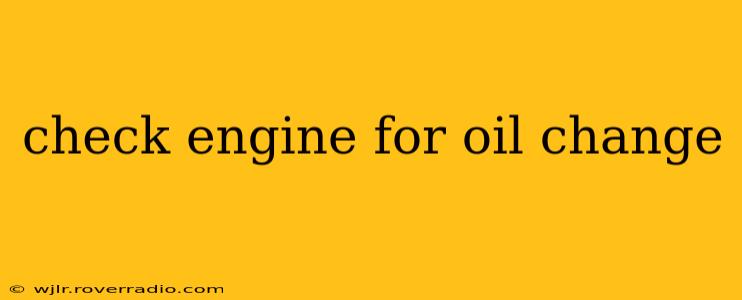The dreaded "check engine" light illuminates on your dashboard, and your first thought might be, "Do I need an oil change?" While a low oil level can trigger the check engine light, it's not the only reason, and it's crucial to understand why before rushing to the mechanic. This comprehensive guide will clarify the relationship between the check engine light and oil changes, helping you understand when to address each issue.
Does the Check Engine Light Come On When You Need an Oil Change?
No, the check engine light itself doesn't directly indicate you need an oil change. The light is a general warning system alerting you to a problem within your vehicle's engine or emissions system. While extremely low oil levels can trigger the check engine light, it's usually accompanied by other warning signs like the low oil pressure light. The check engine light often points to a more complex issue that needs professional diagnosis.
What Other Issues Can Trigger the Check Engine Light?
Many problems can activate the check engine light, from a loose gas cap to more serious engine malfunctions. Some common causes include:
- Oxygen Sensor Issues: This sensor monitors the air-fuel mixture, and a faulty sensor will trigger the light.
- Mass Airflow Sensor Problems: This sensor measures the amount of air entering the engine. A malfunction can impact fuel efficiency and engine performance.
- Catalytic Converter Problems: This component reduces harmful emissions. A malfunctioning converter can trigger the light and negatively impact your vehicle's performance.
- Spark Plug Issues: Worn or damaged spark plugs can lead to misfires, triggering the check engine light.
- Faulty Ignition Coil: This component delivers electricity to the spark plugs. A failure can result in misfires and illuminate the check engine light.
- Various Emission System Malfunctions: Many components within the emission control system can cause this light to illuminate.
How Can I Tell If My Check Engine Light Is Related to Oil?
The most reliable way to determine if your oil is the culprit is to check your oil level using the dipstick. If the oil level is significantly low, you'll likely need an oil change (or oil top-up). But even low oil might not be the direct cause of the check engine light itself. Low oil pressure, however, will often trigger a separate low oil pressure warning light—a much more urgent situation.
What Should I Do If My Check Engine Light Is On?
Don't ignore a check engine light! While it might not always be an emergency, it's a crucial indicator of a potential problem. The best course of action is:
- Check your oil level: As discussed above, this is a crucial first step.
- Get the code scanned: A diagnostic trouble code (DTC) reader can identify the specific problem causing the light. Auto parts stores often offer free code scans.
- Consult a mechanic: Based on the DTC, a qualified mechanic can accurately diagnose and repair the issue.
How Often Should I Change My Oil?
Oil change frequency depends on factors like your vehicle's make and model, driving habits, and the type of oil used. Consult your owner's manual for the manufacturer's recommended oil change intervals. Generally, synthetic oil allows for longer intervals than conventional oil.
Can I Drive with the Check Engine Light On?
While you might be able to drive with the check engine light on for a short period, it's best not to delay getting it checked. Ignoring the light can lead to more severe engine damage and costly repairs.
By understanding the different reasons behind a check engine light and following the recommended steps, you can address the issue efficiently and prevent potential damage to your vehicle. Remember, while low oil can contribute to engine problems, the check engine light itself is a general warning and requires professional diagnosis to pinpoint the root cause.
